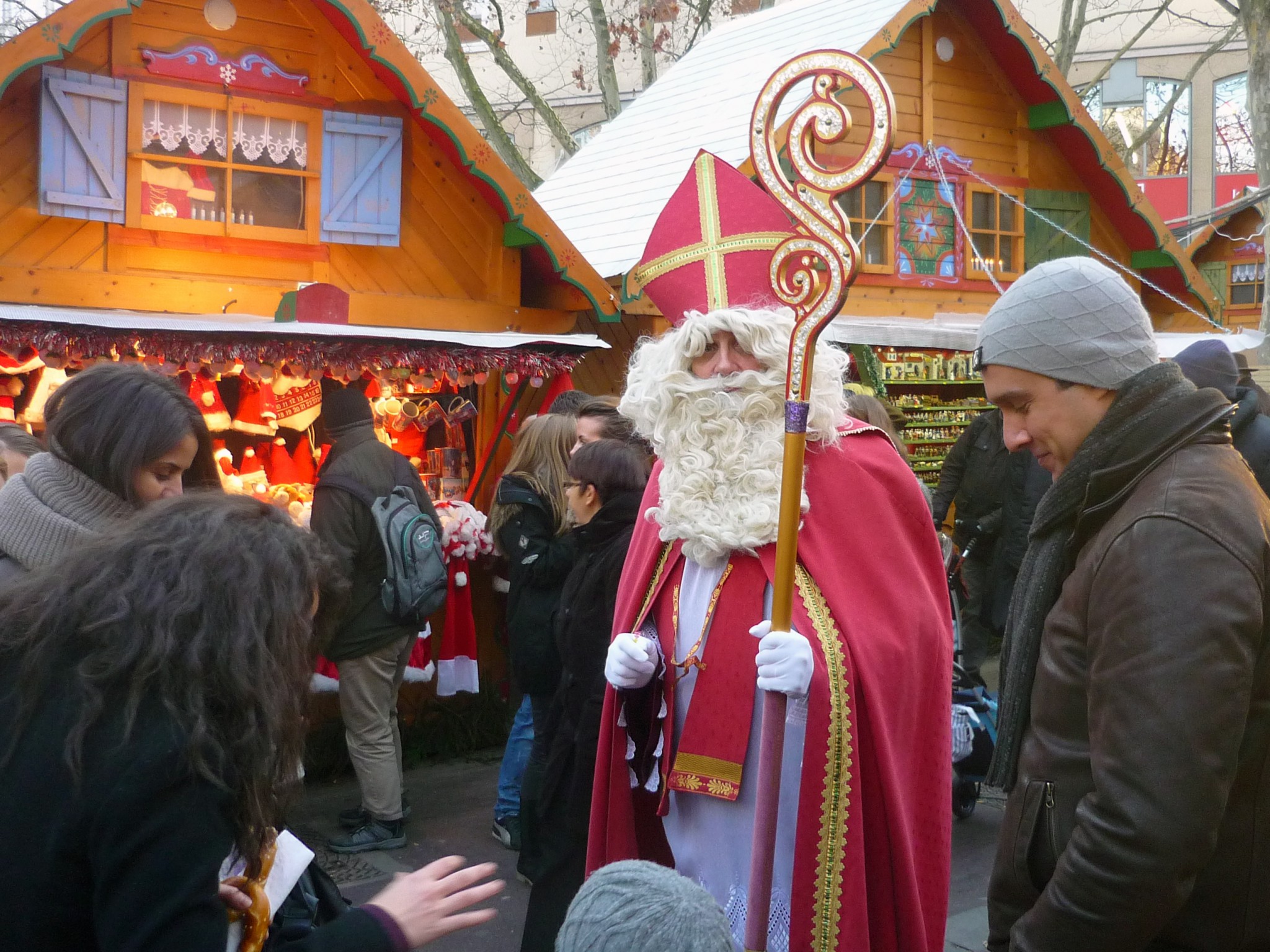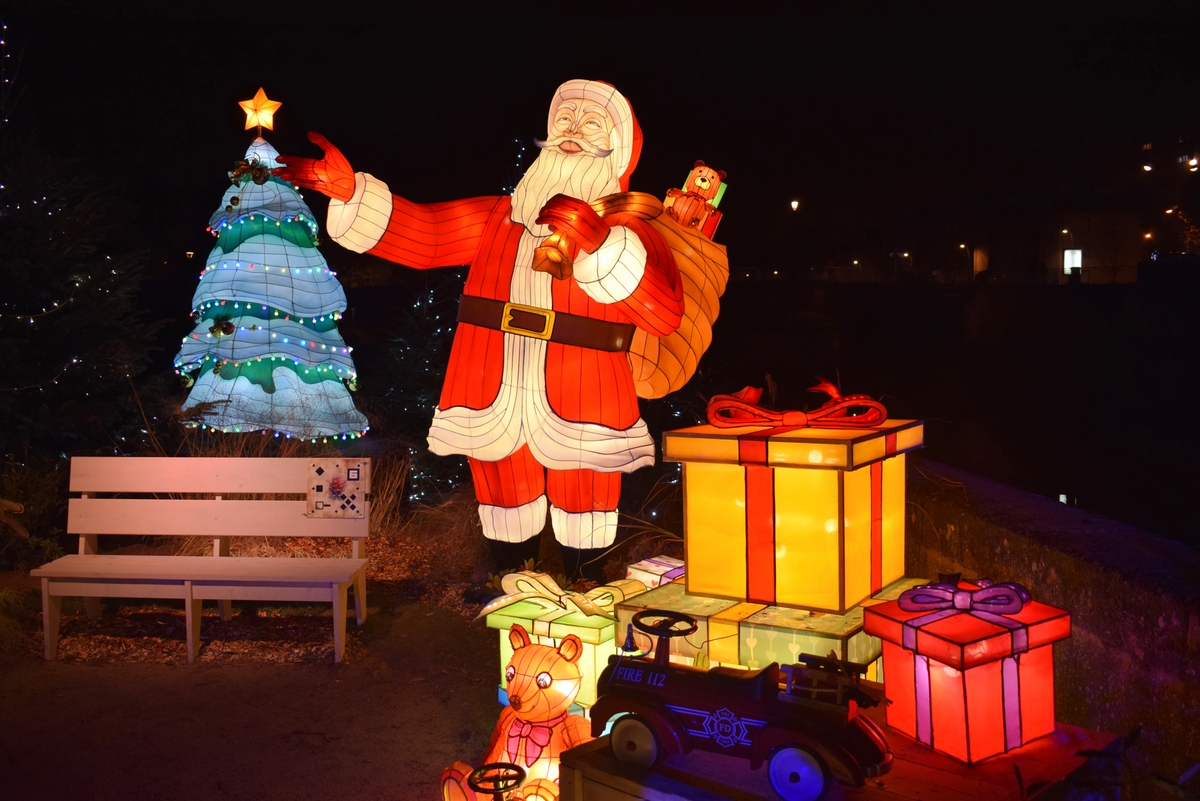Santa Claus in France is called “Père Noël”. Like in any place celebrating Christmas, the French Father Christmas wears a red suit and hat with white fur trim with a broad black belt around his waist. He is tall and large, with ruddy cheeks and nose, bushy eyebrows, a white beard and a moustache. His big brown sack is packed full of toys that will be delivered to every household at midnight, using his sleigh pulled by reindeers.
The origins of Santa Claus
Originally Saint Nicholas (Sinterklaas) inspired the character of Santa. The Patron Saint of Lorraine was originally the distributor of presents to German and French children on 6 December.

The Père Fouettard (the Bogeyman) is the counterpart of Saint Nicholas. He is covered in coal marks and is dressed all in black. He whips/spanks children who have misbehaved, just as Saint Nicholas rewards the good ones. In Alsace, the terrifying Hans Trapp plays a similar role.

With the transformation of Saint Nicholas into our modern-day Santa, Père Fouettard has disappeared altogether. In fact, he has given way to other characters, such as elves and reindeer.
Who celebrate Saint-Nicholas?
The people of Flanders, Lorraine and Alsace, as well as in Austria, Germany, Belgium and the Netherlands. When the Dutch migrated to the United States in the 19th century, they took with them the traditions of Saint Nicolas (Sinterklaas) which gradually evolved into Santa Claus.
The rising of Santa Claus
In a drawing by American cartoonist Thomas Nast in 1863, Santa appears as a peddler. A right jolly old elf distributing presents to all children.

In 1885, the cartoonist revealed that Santa did not come from the sky but from the North Pole. The following year, American writer George P. Webster expanded upon this idea. He added that Santa’s toy factory and house occupied the North Pole.

Then Louis Prang reinforced the cliché. Legend has it that he introduced the tradition of Christmas cards in the United States. Santa wore a broad black belt, boots and a hood. He also carried a very large brown sack full of toys.

Here comes Santa Cola!
Santa’s fame greatly increased in the US at the beginning of the 20th century. He embodied the idea of individual success and the importance of wealth symbols.
In 1931, Coca-Cola commissioned Haddon Sundblom to use the character of Santa as a selling point. The firm wished to enlarge its market towards a younger public. And to help spur sales of the refreshment drink throughout the cold winter!

The colours of the brand – red and white – were used on Santa’s outfit, which has contributed to the unique, modern image of him that we recognise today.
Sundblom based his drawings on some former illustrations published around 1906 before the advertisement. He depicted Santa clothed in red and white, with white whiskers. Thus, Coca-Cola actually only contributed to the popularisation of this new image as a result of marketing campaigns.

Here comes Père Noël!
Until the 1950s, the Nativity symbolised the Christmas season to the French.

It was only after the Second World War that Christmas celebrations quickly underwent an unexpected change. Many argued that the whole celebration of Christmas turned into a capitalist business opportunity.
Suddenly they have illuminated Christmas trees, Christmas cards, and colourful wrapping paper everywhere. Christmas presents also became an unconditional feature of the holidays. Until the 1950s, children were happy with an orange and a very small gift in a sock. In the aftermath of the Second World War, the consumerist traditions crossed the Atlantic and settled in France, such as sodas and chewing-gums.

Thus, the prestige of the American lifestyle was great in France at that time. The “country of the Liberators” fascinated the French. Therefore they embraced popular American icons, including Santa, with a little help from the French press…
A rebellion against Père Noël in Dijon!
In December 1951, the French media reported a particular event that caused a great scandal across the country. The religious authorities of the city of Dijon, Burgundy, decided to crusade against Santa. In front of a crowd of children and adults, they set fire to an effigy in the cathedral square!

It was their way of protesting against the character of Santa, who they considered to be a usurper and a heretic. Santa was accused of “paganising” Christmas. His greatest offence? Public schools welcomed him with open arms… where nativities had previously been banned.

Traditions around Santa Claus in France
In the days leading up to Christmas, French children write letters to Père Noël in class at school, asking him for certain Christmas presents.

Interestingly a law was passed in France in 1962 decreeing that all Santa’s letters would be responded to with a postcard. The idea was that when a class writes letters, each pupil gets a response.
On Christmas Eve, French children used to fill their shoes with carrots and treats for Père Noël’s donkey and leave them by the fireplace.

From the fireplace to the tree
More recently, the Christmas tree replaced the fireplace.
On Christmas night, Père Noël is said to travel the world, stopping at each and every house. He climbs down through the chimney and leaves presents for every child who has behaved themselves through the past year.

Sometimes, seven magical reindeer replace Père Noël’s donkey. They pull an enormous sleigh where Santa takes place. This is in fact an American tradition.
On Christmas morning, children run to the Christmas tree to see what Santa has left under it for them. They often open presents on the evening of 24 December, after the Christmas Réveillon dinner or after the midnight mass.

Not everyone is fond of Santa Claus in France. Some people (particularly children aged less than 5!) suffer from ‘Santa Claustrophobia‘ (‘Paternatalophobie’ in French).
Find out more about Father Christmas
- Read more about the origins and traditions of Christmas presents in France 🎁
- Learn about the story of the song “Petit Papa Noël” 🎶
- Find out more about Santa Claus in France on our French blog Mon Grand-Est! 🎅🏻
Pin it for later
Liked what you read? Pin it on Pinterest:







EWhile I like Santa, the nativity is the most beautiful and a shame it is no longer the centerpiece of the season (which is why there is the season in the first place) in France. Too many American children (and I am American and very familiar with the American Santa image) only identify Santa with Christmas and also miss the message of St. Nicholas in giving , not getting.